|
FAQs on African Cichlid Diseases 10
FAQs on African Cichlid Disease:
African Cichlid
Disease 1, African Cichlid Disease 2,
African Cichlid Disease 3,
African Cichlid Disease 4,
African Cichlid Disease 5,
African Cichlid Disease 6,
African Cichlid Disease 7,
African Cichlid Disease 8,
African Cichlid Disease 9,
African Cichlid Disease 11,
African Cichlid Disease 12,
FAQs on African Cichlid Disease by Category:
Diagnosis,
Environmental,
Nutritional,
Social,
Infectious (Virus,
Bacterial, Fungal), Parasitic (Ich, Velvet...),
Genetic,
Treatments,
Related Articles: African Cichlids,
Malawian Cichlids: The Mbuna and their Allies By Neale Monks,
The Blue
Followers: the Placidochromis of Lake Malawi by Daniella
Rizzo, Cichlid Fishes,
Related FAQs: Cichlid Disease,
Cichlid Disease 2,
Cichlid Disease 3,
African Cichlids in General,
African Cichlid Identification,
African Cichlid Selection,
African Cichlid Behavior,
African Cichlid Compatibility,
African Cichlid Systems,
African Cichlid Feeding,
African Cichlid Reproduction,
Cichlids of the World,
Cichlid Systems,
Cichlid Identification,
Cichlid Behavior,
Cichlid Compatibility,
Cichlid Selection,
Cichlid Feeding,
Cichlid Disease,
Cichlid Reproduction,
|
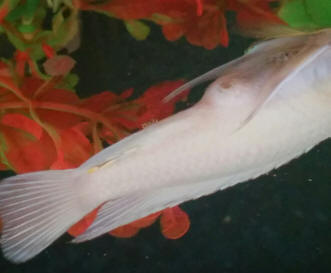
|
About to give up; Mbuna stkg., beh., disease f's
4/4/20
Hi there,
<Hello.>
It was suggested that I forward you guys a post I put up on
cichlid-forum.com today, in hopes you may offer some advice. Here it
is. Thank you.
<Sure.>
Hey guys, new here. Been keeping fish for about 20 years and am so
frustrated the last year or so I’m about to abandon ship. I’ll try
to give the full story. About a year and a half ago I had a thriving
75 gallon Mbuna setup. Beautiful tank with happy fish. Then, I got
the bright idea to upgrade to a 125 gallon and have had problems
ever since.
<Oh dear.>
During the move about a year and a half ago, a couple of the fish
got stressed obviously but all made it until one came down with what
I believed to be columnaris or fin/mouth rot.
<I am glad you've made the connection between stress and disease.
What I'd further throw into the mix is social behaviour. Mbuna
operate best when overstocked. That's because no one fish can
actually secure a territory, and paradoxical as it might seem, the
fish are more aggressive when they hold a territory than when
they're trying to claim a territory. Net result, overstocking
doesn't stop aggression, but it does dial it back. In the wild, the
fish live in huge numbers and have the space for weaker fish to be
pushed out into less desirable areas where aggression is less. For
sure those fish won't be able to breed, but they aren't outright
killed. In captivity, the weaker fish can't do that. Anyway, if your
fish had been overstocked in 75 gallons, and you switched them to a
new, bigger tank, two things would happen. First, all the
territories would be disrupted, so they'd all be struggling to claim
a patch. Secondly, with more space, it's easier for more aggressive
individuals to claim and hold a territory. Their aggression would go
up a notch now, because they'd switch from "house hunting" to
"actively attracting a mate", and that means they'd be even more
aggressive than before. At least, this is how I understand it!>
It quickly spread and I vigorously tried everything to cure my
beloved Mbuna. After a long battle and numerous antibiotics and
treatments, the majority died and the few remaining were horribly
sick and I euthanized them. At that time I took down the entire tank
and cleaned everything and drained it completely. It all sat in my
garage completely empty in -30 degree weather as I live in
Minnesota.
<Well, that should deal with any parasites, but bacteria are well
able to go dormant through such cold, especially if dry.>
Now, a year and a half later I just set up the 125 gallon again and
performed a fishless cycle using Dr. Tim’s ammonia. Cycled in about
a month, and conditions were pristine. Nice hard water, ph around
8.5, no ammonia or nitrites obviously and very low nitrates. Temp is
a steady 77 degrees. I introduced 20 Mbunas from <vendor name
removed> on Tuesday this week. They all appeared healthy but took
cover as expected. None would eat or come out and now it is day 3
and same story. However, upon closer inspection tonight it appears
that several of the fish have symptoms of the columnaris or fin rot
yet again. Could it be that the crap survived on my rock or tank
walls with no water in sub zero temps for over a year?
<Bacteria? Yes. Bacteria are not killed by cold (hence why freezing
food delays spoilage, but doesn't stop it). Furthermore, the
bacteria involved in Finrot and Columnaris are opportunistic and
latent in all aquaria. There's really nothing you can do to stop
them getting into the tank. Even a course of antibiotics diminishes
them, and allows the fish's immune system to clear them out of the
fish's body -- but they will always be present in the aquarium. If
nothing else, their spores get into the tank from our hands, from
the air, likely even in new water unless we're sterilising buckets
and pipes each time we use them.>
I just don’t believe that is possible. I’m so incredibly frustrated
that I’m considering just giving up on the hobby. <vendor name
removed> will refund my money but that’s not the point. I just don’t
get it. Any help or advice would be greatly appreciated. Thank you
<When it comes to this sort of mass death, my gut reaction is to
leave the tank running, fallow, for a couple of weeks. This will
break the life cycle of many parasites. I'd carry on adding fish
food, of course, to give the biological filter something to work on.
A bit of fish fillet or a prawn works just as well, decaying away
over the days, releasing ammonia for the filter bacteria (nitrifying
bacteria) and keeping the good bacteria that start the decay process
(ammonification bacteria) happy as well. If you have a tank where
plants are suitable, and there are plants in Lake Malawi, these are
really helpful too, because they bring in lots of good bacteria on
their leaves and roots. They also help balance the tank a bit,
removing waste and providing a bit more oxygen. Anyway, either way,
let the tank sit for a while. Then sit down and be realistic about
things like water chemistry, water quality, and the frequency of
water changes. I don't often recommend carbon, but if you've had a
mass die-off, the use of carbon (replaced every few days) is one way
to remove dissolved organics that might have been toxic, such as
paint fumes. Even better are the high-end chemical adsorbents like
Purigen. Basically, treat the tank as if it had fish, but do your
best to clean it without killing off the good bacteria. Now, after a
couple of weeks, think about introducing a few fish. Obviously pick
robust species, but the key things with Mbuna are to choose the
least aggressive species first, working upwards through the pecking
order. Juveniles often (always?) travel better than adults, but the
flip side is sexing juveniles can be hard. Finally, and this can be
a bit brutal, if you've utterly failed with one group of fish --
perhaps they aren't the right ones for your water chemistry,
time/budget, etc. Maybe think if some other type of fish might not
be easier. In a big tank, Aulonocara for example might well be a lot
easier to keep than the more aggressive Mbuna, or there may be some
Haplochromis-type fish that would work even better. Hope this helps.
Cheers, Neale.>
|
African Cichlid Fin issues
6/5/19
I have a question for Bob Fenner, after reading through many if the help
topics on the website.
<He's on his travels right now, but will cc him in case he has any input.>
I have a mixed group of African Cichlids, 150gal tank, two Fluval FX6
canister filters. I have about half a dozen fish with a charred, burnt
black looked section on their dorsal fin. I don't think it's fin rot
exactly?
<Black patches that appear out of nowhere are usually ascribed to ammonia
burns or similar. Remember, at high pH levels, ammonia is much more toxic
than in acidic pH. Something to do with the ratio of ammonium ions to
ammonia molecules being different in acid vs. basic conditions. Anyway, the
point being that even 'trace' ammonia/ammonium levels that you'd ignore in,
say, a soft water community aquarium would be much more lethal in a Mbuna
community because of the high pH levels. While we tend to "overcrowd" Mbuna
especially to reduce their territoriality, that does mean filtration has to
be absolutely top-notch, and there's no point having lots of bacteria if
you don't also provide them with plenty of oxygen. I'd also make the point
that Rift Valley cichlids are a mixed bunch, and mixing Mbuna with, say,
Tanganyikans or Aulonocara invariably causes problems eventually, and it
should go without saying you'd not mix any of these Rift Valley cichlids
with soft water species like Kribs or Jewel cichlids from West Africa.>
All the rest of the fins are in perfect condition. Looking for some help, I
can also send photos once in contact with someone. Thank you so much
Adam
<Hope this helps. Neale.>
Re: African Cichlid Fin issues
6/5/19
By mixed, I meant the species, however, all are lake Malawi Haplochromis. I
treat my tap water with Seachem Prime, Malawi pH Buffer and Cichlid Lake
Salt. Attaching a photo of one of the fish. Hope this helps.
<Would still suspect environment, with the possibility of aggression
between the fish causing some of the physical damage. Do check the pH and
water quality; without these information, we can't really help much.
Cheers, Neale.>
|
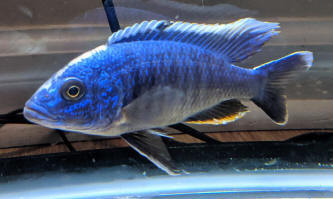 |
African Cichlids wasting away
2/26/19
Folks,
<Hello Mike,>
I am taking care of a tank (180 gallons) that recently has had problems with
assorted African Cichlids. The fins on the fish are looking ragged, the fish are
lethargic, most hovering over the same spot, have had quite a few losses, now
all other fish are not really affected, have Synodontis cats, several Bichirs,
some clown loaches, and two Parrots.
<This is not exactly a textbook community, is it? Even if it isn't overstocked
-- though "some" Clown Loaches could easily fill 180 gallons on their own --
it's a mix of fish with different needs. Hard to imagine the conditions are
ideal for them all, simply because they cannot possibly be.
Clowns need soft to medium hard water with a slightly acidic to neutral pH.
Such conditions would be toxic to Rift Valley cichlids. Furthermore, "African
cichlids" covers a lot of different types. West African cichlids like Kribs are
happiest in soft water, while Malawian and Tanganyikan species want hard water.
Given you have a number of predators (in the form Bichirs) then chances are
you're offering meaty foods (please, no live feeder fish!) and that in turn
means high levels of nitrate are very likely. Nitrate is very toxic to cichlids,
much more so than for most other fish; 20 mg/l can stress then, and 40 mg/l will
noticeably increase mortality via things like Hexamita and HLLE/HITH
infections.>
No new fish were added. I have tried to treat with Seachem Kanaplex as it
appeared to be a bacterial infection which did not help or stop the progression.
Due to increased feedings I have had to adjust my water change schedule to every
two weeks and I am removing thirty to fifty percent of the water, will email the
water parameters upon demand, but have increased the water temperature to 80
just to see if it would help, I am at a loss with this (I am maintaining this
tank but not responsible for the feeding and additions). Please help. Thanks,
Mike
<Cichlids are very much the miner's canary when it comes to high nitrate, low
oxygen, and overstocking. They're exactly the fish you'd expect to see becoming
stressed and sick. I can't pin down the exact problem here, certainly not
without things like water quality test results (nitrite and nitrate in
particular) not to mention water chemistry (general hardness and pH, for a
start). But I'd bet dollars to doughnuts that the problem is environmental, not
a specific pathogen that's sneaked into the tank. A thorough review of stocking,
feeding, aeration, filtration and water changes will need to be carried out. I'd
be looking to clear out the tank a bit, ensuring it's optimised for one
particular set of conditions --
whether softish rainforest type environment or a hard, alkaline Rift Valley
setting. I'd then be aiming for the usual zero nitrite and ammonia, and for a
cichlid tank especially, nitrate levels below 40 mg/l, and ideally below 20
mg/l. While the classic Metronidazole plus an antibiotic combo is a useful one
with cichlids showing vague, but severe, sickness, I'd still only be doing this
alongside a complete environmental review. Hope this helps, Neale.>
Re: African Cichlids wasting away
2/27/19
Crew, Thanks for the prompt reply,
<Most welcome.>
will run the water tests, the problem has been that this tank is in the local
YMCA and the feeding has been erratic, no live foods only flake and pellets for
African Cichlids.
<Flake and pellets safest, so likely not a problem here, though some fresh
greens (such as cooked peas and spinach) do help many types of cichlid,
including Mbuna.>
Yes they are almost all Lake Malawi Cichlids. The aeration is good, oxygen in
the water should not be problem, filtration is performed by two Aquatop 500 with
UV canister filters. I can only perform so many water changes
since they are paying and will only authorize so many.
<Understood.>
I am removing 30 to 50 percent of water each time.
<Sounds good.>
The parameters have not been ideal as far as feeding but the pH is set up for
African Rift Lake Cichlids especially for Malawi Cichlids.
<Understood. But bear in mind that not all fish will handle such conditions
well. Conversely, Rift Valley cichlids won't thrive if the hardness and pH
aren't right.>
Will run water tests this weekend while I have access to the tank and let you
know.
<Cool.>
pH was at 7.6 with Ammonia and Nitrite at 0,
<pH is far too low for either Malawian or Tanganyikan cichlids -- and just to be
clear, mixing them is a really bad idea with one or two exceptions.
You really want to make sure the general hardness is high, and the carbonate
hardness is high. The old Rift Valley Salt Mix is a cheap and effective way to
provide this:
Per 5 gallons/20 litres, add --
1 teaspoon baking soda (sodium bicarbonate)
1 tablespoon Epsom salt (magnesium sulfate)
1 teaspoon marine salt mix (sodium chloride + trace elements)
Stir into the bucket until all dissolved, and then add to the tank. The baking
soda should stabilise the pH around 8, while the Epsom salt helps avoid
bloating. The marine salt mix, while optional, is helpful in adding tiny amounts
of a few other chemicals that keep cichlids in good shape. You can of course use
commercial Rift Valley salt mixes, often called 'cichlid salts' or similar. But
the recipe above is good 'n' cheap!>
however the Nitrates have been high in the past but will retest this weekend for
updated parameters.
<Anything above 40 mg/l can easily explain unexpected cichlid deaths.>
Originally the crew that put this tank up had this scheduled for maintenance
once a month and we reduced it to every three weeks, when that was not enough
now we do it every two weeks. Thanks
Mike
<If time/money is an issue, the easiest option is to reduce stocking level.
This will slow down the build-up of chemicals between water changes, making it
much more easy to maintain good conditions. Tanks often experience problems
after a few years, so if the tank is old, with a lot of muck in the substrate,
pipe work and/or filter, and thorough break-down and deep clean can work
wonders. Do, of course, think about how you're going to keep the fish and the
filter bacteria happy while doing this! Cheers, Neale.>
Adult Male Livingstoni Possible ulcers? Need a Fish Vet
1/3/19
Hello I'm hoping someone can help me and my Adult Male Livingstoni.
His home is my 6ft 110g. It also houses 1 Male OB 2 Female OB 1 Juvenile
Banga, 1 Juvenile Lawanda, 1 juvenile Walteri, 1 Juvenile Mylandi
Sulfurhead 1 Juvenile Malawi Eye Biter 1 Juvenile Firecrest All the
Juveniles are roughly 2 inches and once they are large enough will be
moved to my 220g. He is by far the largest cichlid in this tank and has
also started allowing a few of the smallest Juveniles "clean" his
ulcer/wound.
Which I do
have on
video and is a site to see.
<Sending 30 MB of files in an email clogs up our system; as we
repeatedly do ask, please do crop files to keep them under 1 MB using
the online or offline image editors of your choice.>
My parameters are 0,0,15.
<Ammonia, nitrite and nitrate, I take it.>
I perform weekly 50% water changes, syphon daily any uneaten food.
Filtration is an FX6 and I also have a UV-C sterilizer and a 900 MaxiJet
powerhead. The tank is decorated with petrified wood and an artificial
plant, black sand. My town water is awful, from tap it reads PH 8.4,Gh
4, KH 2. I do use Seachem lake Malawi buffer, salt and Trace, otherwise
my PH
crashes almost immediately. My GH is 7 Kh 7.
<Assuming the pH is steadily around 8.0 to 8.2, this should be fine.
Personally, I'd be upping the KH a bit.>
I think I covered everything?
<So far!>
So my question is regarding my Livingstoni approximately a month ago, I
had to remove him from my 220g. Him and my Venustus decided they
couldn't live together anymore. They lip locked once and my Venustus
nipped him on his side a bit. Once in the 110g I started treating for
his lip which was actually bleeding a bit, he fully recovered in a week
but where he got nipped on the side has grown and gotten worse, then
better, then worse then almost gone, then what the heck it will not go
away.
<Nimbochromis livingstonii, like most Haplochromines, do extremely badly
when kept with Mbuna. So that was your first mistake. Sooner or later
they're harassed or nipped by Mbuna, and absolutely should not be
mixed.>
His fins are perfect, eats great, activity level is normal but these
ulcer looking spots. At first I thought oh no Columnaris, etc.. But I'm
starting to think it might be viral? Due to the amount of time this has
been an issue and NOBODY in any of my tanks, including his tank mates
have or had anything similar or wrong, even the juveniles that are
cleaning the site have no signs of whatever this is on their mouths. I
so wish there was more Fish Vets available, I've talked to an assistant
and she told me Melafix and Pimafix but it did nothing.
<Useless products.>
I've tried Kanaplex in water and feeding, I've fed Metroplex.
<Indeed, Metronidazole and a reliable antibiotic would be good choices
when treating sickly cichlids.>
I'm now performing water changes every 3 days and I'm ready to either
clout the tank or use CopperSafe. I live in Massachusetts, if I could
find a vet I'd be more than willing to pay for a house call. He is so
big and smart that he sees me go to the cabinet with my nets and
immediately starts swimming in a frenzy ready to attack it. So in my
mind at least, catching him will only add more stress and most likely
injury.
<The video suggests he's being pecked at by other fish. This will
prevent any effective healing, and will certainly be adding to his
stress.
Isolating, and medicating as per Finrot and probably Hexamita will
help.>
Thank you Liz
<Cheers, Neale.>
Pseudotropheus zebra - pH related illness
6/11/17
I have a 55 gallon tank that I set up on 5/26/17 for young
Pseudotropheus zebras that I am raising from fry. I have many tanks and
have had tanks for nearly 50 years since I was a kid.
<Neat!>
Everything was going great until I did a partial water change.
<Oh?>
I did a partial water change (20 gallons) on Tuesday (6/6/17) and on
Wednesday they were stressed out. I am a geologist and work with
biologists and engineers. Through a series of tests with meters etc... I
figured out that I got a batch of acidic water which was used for the
partial water change.
The water that was used had set for 4 days before using, so I did not
use any Dechlor. I avoid using Dechlor unless I have to..
<Hypo, Sodium Thiosulfate; olde timey prep. for the simpler time of
chlorine-only use as municipal sanitizer. Chloramines are used almost
universally in the USA nowayears... Dechlor won't remove/change these.
Best to do as you suggest and let water sit or aerate days (or week)
ahead of use>
I dumped the water from the buckets on Thursday 6/8/17 and filled them
with fresh water. The pH and all other parameters tested well and that
water has been used now for 2 partial water changes... ( 10 gallons
each)... one on
Wednesday 6/7/17 and one on Friday 6/9/17.
I kept the light on from Wednesday night until this morning at 6:00 AM
and turned it back on at 1:30 PM today.
My questions involve my approach from here on out. Some of the fish are
eating... about half of them... but not with the normal intensity. The
others have no interest in eating. Some are scraping themselves
occasionally and a couple have what looks like damage to their slime
layer. It is not white fuzz and does not look like ich... but more like
bubbles.
<Mmm... am wondering what this is>
I am old school and have a Marineland emperor 400 outside filter and two
550 powerheads with and undergravel filter. The setup is only 15 days
old, so the carbon and the media in the filter is pretty new.
I am very concerned about the health of the fish. I have cared for these
fish since I harvested from their moms and setup the 55 gallon just for
them.
The quality of the aged water I have is back up to par with what it
should be and I am preparing to do water changes in my other 7 tanks.
<I would stick with your water S.O.P., but add testing it ahead of
actual use... and depending on its composition, add some salts and
alkalinity blend (commercial or DIY) ala the "Malawi Mix" detailed by
Neale here:
http://www.wetwebmedia.com/fwsubwebindex/fwh2oquality.htm
What are your recommendations to improve the health of my African
cichlids?
<Per the above; addn. of the bicarb., MgSO4, NaCl>
I am planning another partial water change today (10 gallons only) and
thinking about replacing the carbon in the emperor 400,,, even though it
is only 15 days old. I think that I am going to leave the light on since
they seem to do better at this point...
<Mmm; am not such a fan of GAC use in freshwater systems... better to
leave "a unit" or more in and transfer out a new one every month or so.
Many years back our service companies used a huge number of ChemiPure
packets in
this way... in the years of Eheim canister filters and in sumps>
I have various types of medicine, but II fear that removing the good
bacteria would be more harmful than the medicine would be helpful....
<Agreed. I would NOT treat the current situation with medicines;
particularly antimicrobials. More likely to interrupt nitrification,
make matters worse than better>
Thanks for any help that you can give me.
Darrin
<Glad to share and hope this helps. Bob Fenner>
|
Please help me help my bumble bee
1/14/16
I've purchased my bumble bee cichlid from my avid fish loving brother a couple
of months ago. Along with a blood parrot and currently small green terror.
Bumblebee had these growths before i brought him home for quite some time,
although, nearly half this size.
<Apparently some sort of infection of the nares>
Not sure on age but he's around 5 inches long. I have been doing water changes
accordingly. His health is declining and in his weakened state he's being easily
chased into hiding from the blood parrot when in the beginning they all did well
together
with ample hiding places he seemed completely healthy aside from the unsightly
growths. I've noticed today he did not eat. Came out long enough for me to snap
this picture. Im worried. Im hoping its not a tumor but with it only seeming to
grow i am not sure what else this could possibly be.
<Likely some sort of infectious agent, proceeding from environmental stress....
"poor water quality" of some kind/s>
His color no longer seems to change mostly remains faint. I thought maybe the
growths could fall off but nothing in all this time. in the last week a bump has
formed in between the nostrils under the skin. Only looking worse. If there is
ANYTHING i can do to save him please please let me know.
<Well; if it were mine.... I'd likely euthanize this specimen (see WWM Re)...
but if you're willing to try.... I'd subject the entire system to a modicum of
"Malawi Salts" (see Neale Monk's works re on WWM); and trying a "Furan" drug
(Nitrofuranace my choice) here per SOP statements on WWM. Bob Fenner>
|
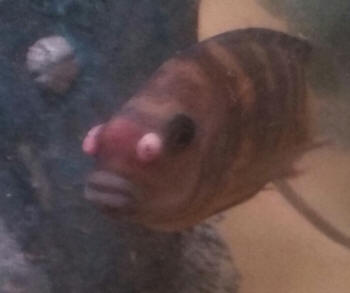 |
dying fish, generic stmt.s re African Cichlids, no data, rdg.,
11/5/2015
using WWM
Good day
<And you>
Im hoping i get an answer to my question. Okay so i started of with a 3foot fish
tank only to realise after 3months its way to small for my African cichlids so
decided to go bigger and hooked up a 5 foot fish tank, ever since i did the tank
swop i am losing at least 3 fish a week could you please advise me to
why this is happening.
<Mmm; very likely to territoriality issues.... "African Cichlids" (Mbuna likely
here), don't "get along" well, and have to be either tenuously over-crowded or
quite under-crowded.... There are other possibilities... water quality, system
issues... even some possibility of pathogenic disease. You offer no data or
imagery of any>
Your feed back would be highly appreciated.
<Let's have you read: HERE:
http://wetwebmedia.com/AfCichDisDiagF.htm
and the linked files above. Bob Fenner>
Thank you.
|
Newbie again. Cichlid issues, crappy water
9/27/15
Thank you for the advice on my koi. She's healing well and doing great.
Now I have a question on my cichlids.
60 gallon, 14 cichlids, parameters have been running: 76 degrees, 0 nitrites,
0.25-1.0 ammonia,
<?! Needs to be zero, zip, nada>
0 nitrates, (yes that is nitrates NO3), high PH is less than 7.4, and PH
is running 6.0.
<This varying pH makes no sense to me>
All are pissed off at each other, which I've heard means they are happy.
One has two white dots, which look like bubbles in a photo so I've attached a
video as well. Any idea what this could be?
<.... environment. Read, fix this.... boost alkalinity/reserve. Bob Fenner>
|
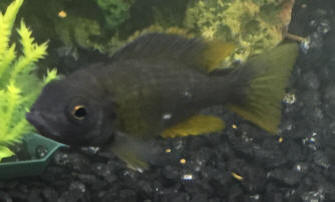 |
|
Giant Venustus Sinking Uncontrollably
8/14/15
Hello,
I wonder if you have heard of this, and would greatly appreciate any input you
may have for me. I'm growing concerned about my giant male venustus, or at least
I assume he's male since he has the bright blue face. I've probably had him for
7 years, and he's between 7 and 8 inches long. He's always been a big pig, with
a pretty big belly(while all my other cichlids
over the years have had completely normal bellies), and he's always been on a
pellet mix diet; floating and sinking. He is still wanting to eat, but just
recently has been acting like he's got a lead weight in him. He went from
leisurely cruising the tank at the upper - mid regions, to sitting on the bottom
constantly, however, very alert. If I walk up to the tank, he gets excited for
food, swimming around at the top like he always has, but as soon as I move away,
he drops - literally - like a rock to the same spot on the bottom, as if it's
extremely difficult to stay up. Oddly enough, his color and eyes still look
good...and if he was just getting old I would expect him to be fading. After
doing a little reading, it seems as though it's a common problem for fish to
float uncontrollably, but I have yet to read anything about sinking
uncontrollably. I've been trying the peas, which he won't eat, and switched to a
green 'veggie' pellet, in the hopes of loosening any possible constipation, and
I've added a couple small doses of salt,
<Epsom salt, not regular salt!>
which I have never done on a regular basis. All the other fish seem to be doing
just fine, although not too happy about the peas, and there are currently a
handful of tiny babies in the tank, which has never happened to me before in the
11+ years of having cichlids (the babies don't resemble the venustus at all).
<They often won't in a mixed species set-up. Unless you separate Malawian
cichlid species, you tend to end up with various hybrids from the closely
related species. Such fish are often rather drab in appearance.>
Even though he seems to be doing pretty good right now, my biggest concern is
the damage he'll inflict on himself and to his belly and fins, repeatedly
hitting/landing on the bottom that hard.
Let me know what you think, and thank you,
Lindsay
<Seven years isn't especially old for a cichlid this age, though certainly
middle-aged and perhaps a bit more prone to problems because of that. I think
you're right about constipation being an issue, but since this fish a carnivore,
you're unlikely to get much interest in cooked peas. Instead try live or frozen
brine shrimps and daphnia, both of which have a laxative
effect, and be sure to use Epsom salt (not regular salt) alongside it.
http://www.wetwebmedia.com/fwsubwebindex/gldfshmalnut.htm
http://www.wetwebmedia.com/fwsubwebindex/SaltUseFWArtNeale.htm
Cheers, Neale.>
|
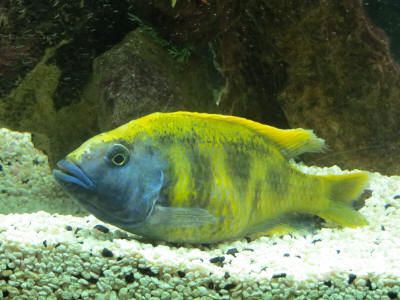 |
|
Re: Giant Venustus Sinking Uncontrollably
8/15/15
Thank you very much for your quick response and advice.
<Welcome.>
No, I certainly wasn't using regular salt, but I was using some API aquarium
salt, as that's all I had.
<Despite the packaging, this is not much different to table/regular salt, as in
sodium chloride. I'm told it's made from seawater, but whatever it is, it's
mostly (if not entirely) sodium chloride, with some other calcium salts added.
Nothing special, and not worth paying a premium for!>
I will try Epsom salt if that's the better choice. I only mentioned the babies,
because I didn't know if his behavior would have anything to do with that. I
believe the babies look like an exact mix between a pale blue socolofi or a
williamsi...... and an electric blue or a masoni... that's the best guessing I
can do as to which species they are.
<As stated earlier, likely hybrids. No resale value, and many in the hobby get
angry about them, but as pets, provided you don't sell them to someone else as a
particular species, no harm done. Most of the common fish (Angels, Goldfish,
Mollies, Platies) in the hobby are hybrids, by the way, so hybridisation isn't
evil. But people who keep Rift Valley cichlids tend
to want to know what they're getting because each species has specific
requirements, adult sizes, and crucially, behavioural traits. Hybrids aren't
predictable, so if you buy some, you might end up with a psycho fish or a giant
fish or who knows what.>
You know how it is; most fish stores label their tanks "assorted cichlids" so
it's difficult to figure out exactly what you've got.
<For sure. Would not recommend anyone buying "assorted cichlids" as they're
almost always hybrids.>
Either way, those 2 fish look like the culprits for making babies; not the
venustus.
<Understood.>
I'll try the brine shrimp in the hopes that this is a constipation issue.
The only other thing I've ever fed, more or less as a treat once a week, are the
frozen blood worm ice cubes (pre-thawed in water of course, because this big pig
will grab a whole one if you let him).
<Bloodworms are a favourite, for sure, and my fish love them. But they have been
implicated in a variety of health issues. Fairly or not I can't say, but I would
lay off them if your fish are ailing in anyway. They're cultivated in sludgy
sorts of ponds, whereas brine shrimps (and to some extent daphnia) are
indicative of clear, clean water.>
Everybody in the tank loves the blood worms, but I haven't done that in the last
couple weeks since he started sitting on the bottom.
<Ah, good move.>
I'll admit though, it's quite shocking to see him sink so fast, and hit the
bottom so hard, when he's done hanging out at the top waiting for food. He
literally acts like he has a lead fishing weight in him or something. Have you
honestly ever heard of or seen this?
<Many times. Problems with buoyancy are commonly related to constipation,
especially when fish are otherwise healthy (i.e., active and feeding).
Occasionally swim bladders become infected or damaged, but this is much rarer
than people believe. On the other hand, when fish are truly sick and infected
with internal bacteria, loss of buoyancy is often one of the more dramatic
symptoms. Fish have to have just the right amount of gas in the swim bladder,
too much or too little causes them to float or sink.>
As opposed to fish that floats uncontrollably, which seems more common?
<Perhaps.>
Thank you again,
Lindsay
<Good luck, Neale.>
Re: Giant Venustus Sinking Uncontrollably
8/15/15
Your email has been deleted due to too-large file size. See our requirements and
re-send.
|
Fwd: Giant Venustus Sinking Uncontrollably
8/16/15
Thank you again Neale, Ill try some brine shrimp and switch to some Epsom salt.
<Cool.>
Yeah, I'm a little surprised by the babies; I can't believe I've never had any
before now. I'm kind of hoping the larger fish will control the population a
little for me, but everybody in my tank is fairly non-aggressive, and nobody
really seems to care about the babies. The babies are actually very hardy and
are very quick to find a good hiding place . I'm going to have a very 'blue'
fish tank if they all survive!
<Indeed.>
I think Phoenix, AZ might be slim pickings for fish stores. We pretty much get
PetSmart, PetCo, and the occasional fish and aquarium store where some of the
tanks are labeled appropriately, but some just have a ton of mixed fish. I try
to avoid the drab ones that seem to be hybrids, and go for the ones that i
recognize as being more pure, but I'm sometimes limited to the
'assorted' tanks because of the size of fish I need. If I'm adding a fish to my
tank, they have to be big enough to hold their own.
<Is mail order not an option?>
Well, I appreciate you taking the time to talk with me, I've actually enjoyed
this very much. Thank you.
<Most welcome.>
Just for kicks, I'll attach pictures of the fish I was describing that I believe
to be the parents of the tiny blue babies. Maybe you can see if the adults look
like hybrids or if they're each legit.
<Certainly Pseudotropheus of some sort, Pseudotropheus zebra perhaps for the
pale blue one, maybe for the darker one too, but hard to be sure. Not an expert
on identifying Pseudotropheus species I'm afraid!>
Thank you again,
Lindsay
<Cheers, Neale.>
|
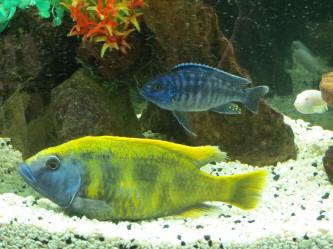 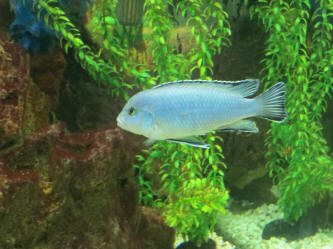 |
|
|
|
|
Intermedius cichlid... hlth.
8/9/15
Hello!
I'm writing to inquire about what appears to be a cluster of red lumps
on my intermedius cichlid's fin.
<Looks like Lymphocystis or some other viral infection.>
The fish is a few years old and has been living in my 125 gallon tank with about
20 tankmates. No one else is exhibiting anything similar. He is fine in regards
to eating and swimming normally. Aggression is minimal and water parameters
tested fine as far as nitrates, nitrites, Ph, etc.
<Please don't tell us "fine" but instead give us the numbers. To be clear:
most of these viral infections are triggered by environmental shortcomings.
Actually quite a body of research into this because wild fish with viral cysts
are potential indicators of environmental pollution. So something's amiss.
Either review yourself and act accordingly, or send us some numbers. To recap:
Malawian cichlids like Tramitichromis intermedius must have hard, alkaline water
(15+ degrees dH, pH 7.5-8.5). Ammonia and nitrite must be zero of course, but
nitrate must also be as low as practical, ideally below 20 mg/l. Water
temperature should be middling to warm (25-26 C/77-79 F is fine) but there must
also be lots and lots of oxygen, so heavy duty filtration is critical, water
turnover rates of not less than 8 times the
volume of the tank per hour (so for a 125-gallon tank, the filter should provide
at least 1000 gallons/hour turnover). Tramitichromis intermedius is one of the
open water, non-Mbuna cichlids. It must never, EVER be combined with Mbuna
except perhaps the very mildest ones (Labidochromis and Iodotropheus). It's a
peaceful species that works well with Aulonocara-type things, and will get
stressed with Mbuna, and yes, that sort of stress can/will cause diseases such
as Lymphocystis. Finally, since he's a sand-sifter, you'll want a sandy
substrate but check you use a good quality kind that isn't sharp and is kept
clean with periodic stirring and siphoning.>
I've attached a few pictures if you could please advise what you guys think it
may be. Sorry for the quality, he wasn't listening when I said to sit still.
<They don't tend to, no.>
I really don't have a hospital tank big enough to suit him at the moment, he's
quite a large boy. If need be I can purchase a 20 gallon.
<There's no real treatment to viral infections, and they tend to go away after a
few months (or years!) of good care. Not contagious in any meaningful sense, but
what has stressed this fish might stress others, so review and act accordingly.>
Thank you,
Lauren
<Welcome. Have cc'ed our cichlid experts in case they have other ideas. Neale.>
|
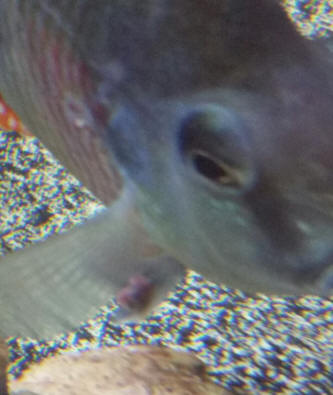 |
|
Re: Intermedius cichlid 8/10/15
As far as numbers go my Ph is 7.8,
<Any idea the hardness? Especially the carbonate hardness, which is involved
with minimising pH changes between water changes. The addition of calcareous
material to the aquarium (tufa rock for example) will raise carbonate hardness,
as will the use of Rift Valley salt mix, which you can make thus:
Per 5 US gallons (20 litres) add the following amounts of each ingredient:
* 1 teaspoon baking soda (sodium bicarbonate)
* 1 tablespoon Epsom salt (magnesium sulfate)
* 1 teaspoon marine salt mix (sodium chloride + trace elements)
Stir well, add to the tank, and you're done. As always, don't make dramatic
changes to water chemistry all at once. Across a serious of water changes,
perhaps 20% per day, would be a good approach.>
ammonia and nitrite 0, nitrate is currently between 10-20 (the color in the test
tube is between those two), and almost always under 20 except in rare cases like
being away on vacation and not being able to do a water change that week, which
might be the issue since I was gone recently for 10 days?
<Possible, and such "oversights" do sometimes trigger problems with cichlids.
But I'm not convinced that we can explain away the problem.>
I did a water change and test as soon as I got home and parameters were almost
identical to what I listed above.
<Good.>
Temp is 78. I run two MarineLand canister c360 filters and two large air stones.
I do have a Carib sea sandy substrate. Most of the tankmates are Aulonocara, I
have three Labs, and one Iodotropheus. Almost all of the aggression is between
the two dominant male peacocks in the tank.
<Predictable! But otherwise sounds fine.>
So I don't know if he was stressed out by water issues or aggression when I was
gone, but the cyst didn't appear until after I was home for a week.
<Hard to say. I'd maybe treat as per Finrot in case there's a bacterial
infection, but otherwise optimise environment and diet, and see what happens.>
Lauren
<Do have a read:
http://www.wetwebmedia.com/lymphfaqs.htm
But also here:
http://www.wetwebmedia.com/virdisnonlymph.htm
http://www.wetwebmedia.com/virdislymphf.htm
http://www.wetwebmedia.com/virdiscures.htm
And also follow the relevant links. Cheers, Neale.>
|
|
Cichlid with Popeye and Red Stuff (17 megs...)
5/22/15
<Your email has been deleted due to too-large file size.>
Cichlid with Popeye and Red Stuff... six Megs, no use of WWM
5/22/15
Hi! I have been reading for a few days now on how to fix PopEye,
<Mmm; this is a physical trauma... either the fish was attacked or swam hard
into something>
which is what I think one my cichlids has. His left eye is popped out and has
something red popping out as well. I have attached a picture to see what you
think. To give a little background, I have a 150gal Cichlid tank I got a
year ago from a previous owner. It has 2 Eheim Pro 2 Canister Filters,
2 heaters, and a power head to move water. I have the API master test kit, and
ammonia is always 0 nitrite is always 0 and nitrate is normally 10ppm
<Good values. I do hope/trust the water is hard and alkaline for this Mbuna>
or lower, but lately in 3 out of the 6 tanks I have the nitrates have
been 40ppm.
<Too high by twice>
I don't know how to get it lowered
<? READ on WWM re>
as water changes and keeping it clean have no effect. Is it the nitrates
that is causing the problem with his eye?
<Could be related>
Is it contagious?
<No... unilateral exophthalmia... SEE READ ON WWM RE>
All the fish are full grown and very active I would hate to lose any. I feed
them Wardley Advanced Nutrition Perfect
Protein and sometimes they get frozen bloodworms
<And this>
and brine shrimp with Spirulina. Sorry for the long email, just really worried
about my tank. Any help you can give would be great! Also today with the water
change I added 1cup of Epsom salt as I saw it was recommended Alot
<No such word>
is that okay? Or will it even help?
<Could possibly help. Again; ALL THIS IS GONE OVER AND OVER ON THE SITE>
Thanks again.
Becky
<Look for sharp objects in the tank and/or other mean fish/es... and
remove. Bob Fenner>
|
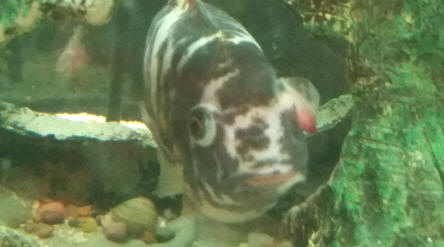 |
2 dead kenyi cichlids in 3 days 4/2/15
Hi there, I bought four juvenile kenyi cichlids one of the
males was already turning yellow so I bought it as I wouldn't have to wait long
for them to pair up. Now the main problem is that I have got two
cichlids dead with same symptoms. Before the first one died it started
sinking and couldn't stay upright and rolled to its sides and died within three
hours of showing these symptoms.
< Something very wrong here... environmentally or socially>
The second one too showed these symptoms
<Which are?>
and died in the same time period, in the second death I noticed that their
bellies became a little orange/reddish/brownish. I can't
specify the exact colour but the main thing is that it looked like swim bladder
disease
<.... there really is no such thing. Like "cold symptoms">
so immediately transferred it to a jar and started the fasting treatment where
it died now I want to know how could have I saved them so that I could tackle
any situation like this in the future.
Thanks
<... I'd be checking the water quality here. As two of the four are living, am
given to suggest that the other two are culprits.
Bob Fenner>
Re: 2 dead kenyi cichlids in 3 days 4/3/15
I do a 10percent water change everyday
<Do you have measures for Nitrogen compounds?>
and I haven't seen any fighting now as you said that the other two might me
culprits they are not as the third one died today showing the same symptoms
(lethargy, sinking to bottom, inability to be upright, loss of appetite, staying
in the corner).
<Env...>
So, I did a 100 percent water change and added rid-all general aid
<Not a good idea>
the last one is a male kenyi cichlid and has now started to show the same
symptoms and yes I also have a breeding pair of swordtails they eat
energetically but cichlid stay at the bottom and usually hides behind the filter
what should I do I don't want my last cichlid to die. Could the reason of deaths
be starvation as the last cichlid haven't fed for about 36 hours now
<Let's have you read.... starting here:
http://wetwebmedia.com/AfCichDisF10.htm
and the linked files above.... to give you insight into what might be going on
here. BobF>
2 dead kenyi cichlids in 3 days /Neale
4/4/15
Hi there, I bought four juvenile kenyi cichlids one of the males was already
turning yellow so I bought it as I wouldn't have to wait long for them to pair
up. Now the main problem is that I have got two cichlids dead with same
symptoms. Before the first one died it started sinking and couldn't stay upright
and rolled to its sides and died within three hours of showing these symptoms.
The second one too showed these symptoms and died in the same time period, in
the second death I noticed that their bellies became a little
orange/reddish/brownish. I can't specify the exact colour but the main thing is
that it looked like swim bladder disease so immediately transferred it to a jar
and started the fasting treatment where it died now I want to know how could
have I saved them so that I could tackle any situation like this in the future.
Thanks
<Almost certainly an environmental issue. When a bunch of fish die within a
short space of time, and the symptoms are generic, you can usually blame the
environment. Obviously water quality is important. As with all cichlids,
tolerance for nitrite and ammonia is minimal, but Mbuna generally have a
relatively low tolerance for nitrate too, so frequent water changes are as
important as filtration and aquarium size. Since these are Rift Valley cichlids,
water chemistry is the second factor of crucial important.
Hard, alkaline conditions are essential. Some folks think adding salt will do
the trick, but that's not true. You need a full range of mineral salts.
There's a cheap Rift Valley salt mix that's been around for decades that makes a
fine alternative to store-bought equivalents.
http://www.wetwebmedia.com/fwsubwebindex/RiftVlySaltMixF.htm
Do bear in mind that moving a fish from a main aquarium to a "hospital" aquarium
is ONLY useful if the hospital aquarium has BETTER conditions than the main
aquarium. Sticking a fish in a jar because you recognise it needs to be isolated
will in fact do more harm than good. Isolate a fish, for sure, but do so in an
aquarium with a mature filter, heat, and sufficient
space (for small fish, a 10-20 gallon tank works well for hospital tank use).
Finally, can I state clearly that THERE'S NO SUCH THING AS SWIM BLADDER DISEASE.
Gosh, that felt good to get out! What I mean is that fish roll over, swell up,
and find it hard to swim for all sorts of disease-related reasons. For sure,
sometimes there may well be a bacterial infection in the swim bladder alongside
infections of other internal organs. But there isn't a common aquarium fish
disease specific to the swim bladder, and when fish roll over or swim oddly,
it's time to review the environment and ALL aspects of fish health, not Google
"swim bladder disease". Make sense?
Cheers, Neale.>
RE: 2 dead kenyi cichlids in 3 days 4/4/15
Thanks it helped a bit as when I changed the water, raised the temp.and siphoned
the gravel it showed a little movement and haven't died till now anyway it
pooped today a little after a lot of time but still isn't completely healthy
could it be constipation? Thanks
<Like all Mbuna, Maylandia lombardoi is predominantly a herbivore. So assuming
you're providing a diet based on greens (Spirulina flake, cooked spinach,
slivers of cucumber, etc) with only occasional zooplankton treats (brine shrimp
are ideal because they contain algae!) then constipation shouldn't be a problem.
On the other hand, feed them standard flake, bloodworms and other meat-based
foods, and yes, Malawi Bloat is a real risk. Cheers, Neale.>
|
Mysterious cichlid sickness
2/5/15
Internal Lake Malawi Cichlid Disease
Hi, I have been looking all over the internet for an answer to my tank
troubles but have yet to find an article that can explain what I am
currently dealing with. I'm going to attach a picture of the fish I lost
yesterday morning. I had 3 cichlids and an algae eater in a 20
gallon tank. Our white cichlid, not exactly sure what kind of
cichlid sorry, died suddenly but for a few weeks he was acting a bit
strange. He was constantly twitching, flopping on the pebbles, darting
across the tank etc...Then I noticed his tummy looked almost black and I
figured maybe he is actually a she and she's pregnant. Over about a
weeks time the fish dug itself what I thought was a nest in the pebbles.
He dug all the way down to the glass, this nest was about the size of a
baseball around. He became territorial of that spot and wouldn't let the
other 2 cichlids near it. He was eating normally and everything. I woke
up yesterday morning to him floating upside down with a perfect hole in
his stomach (or I guess anus) almost as if something ate him from the
inside out....and on the bottom of the tank there were these weird jelly
like balls about the same size as the pebbles. There were purple ones
and see through ones, which I'll also attach a picture of. Now that same
morning I woke up to the dead fish, my yellow cichlid who naturally has
a black stripe down his top and bottom fins, is also struggling to stay
alive. He has dark stress stripes down his body, his mouth was pushed as
far open as he could get it as if he's gasping for air, and he was
staying at the bottom of the tank in one corner. The lady we get our
fish from told me its definitely ammonia poising but doing a water
change did absolutely nothing. We put the yellow cichlid, our blue
cichlid, and our algae eater in a makeshift hospital tank with an air
pump for the time being until we set up a new tank and let it cycle
thoroughly. The yellow guy seemed to thrive when we switched them over
to the hospital tank but now after just one night he's not looking so
good again. I have added some Melafix to the water and because there's
no filter on this tank am doing frequent water changes and keeping an
eye on the temperature keeping it around 80. Should also mention the
yellow guy now has a "lump" under his mouth as if he's got something
growing inside of his throat. This lump has a small diagonal "cut"
through the middle of it that some what resembles the open wound found
on the dead white cichlid. His mouth is not pushed open as far as it was
yesterday morning but you can tell he's still having a hard time
breathing. Love these little guys, this is the first time we've had a
problem with the fish in this tank since we established it back in
august of 2014. Hoping you can help me out here any info you may have
helps!!
< Your Lake Malawi cichlids are vegetarians and should be fed a
diet high in vegetable matter. Foods that are too meaty will rot
in their gut causing the jelly belly affect you are seeing. They
should be kept in the mid 70's.
The 80 F temp is way too high and that by itself could cause some of the
problems. Read up on Lake Malawi cichlids and how to care for
them.-Chuck> |

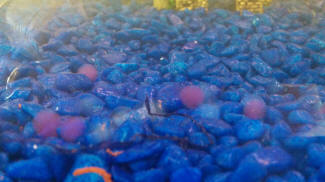 |
|
My Electric Yellow is skinny between the fin and tail
1/29/15
Hi,
<Kel>
I recently changed my tank from community fist to Chichlids and last
Saturday I bought a couple baby African chichlids for my tank.
<Cichlids, not the gum sounding name>
The following day I noticed one of my electric yellows was looking
really skinny. Between it's fin and tail it is very skinny.
<I see this in your pic>
Can you please help? I have spoken to the pet shop and they don't know
what is wrong with it. I can not remember it looking funny when I bought
it though I can not see how over night it would end up like this. I have
attached a pic and in the pic you will see both my electric yellows. The
bottom one is the one I am concerned about. I have since separated it
from the tank incase it is bad but it is now only hiding and hardly
eats. I am not sure if it was eating well when I first bought it. What
should I do?
<Not panic... there might be some sort of pathogen, infectious or
parasitic involved here, but more likely than not by far this one fish
is simply "starved". Your good care (feeding and water quality) will see
its rapid improvement. I'd be feeding a high quality small pelleted food
(e.g. Hikari, Spectrum) three, four times per day; making sure the water
is hard, alkaline and not too warm... as gone over and over for
Malawians on WWM>
Cheers,
Kelly
<Welcome. Bob Fenner> |
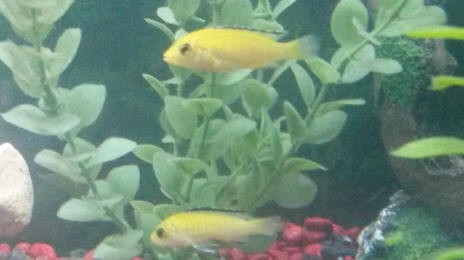 |
|
|

